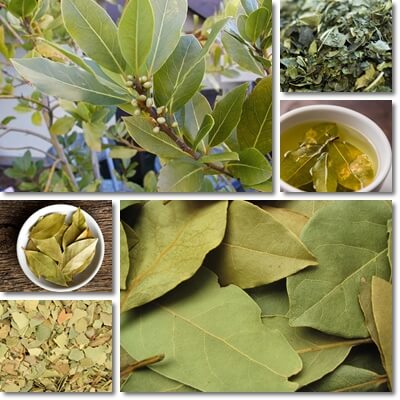Bay leaf tea is a herbal infusion made from the dried, whole or ground leaves of the bay leaf or bay laurel herb (Laurus nobilis).
Bay leaf tea holds benefits for diabetes management, having measurable blood sugar-lowering effects. The herbal infusion exerts anti-inflammatory and antimicrobial properties, has an anxiolytic action and is successfully used for stress relief and anxiety control.
Other bay leaf species may be used to make bay tea such as the California bay leaf (Umbellularia californica), Indian bay leaf (Cinnamomum tamala) or West Indian bay leaf (Pimenta racemosa).
However, there are somewhat notable differences in the aromatic compounds profile between the different bay laurel species which may affect both flavor and the the therapeutic activity of the tea.

How to make bay leaf tea at home
From whole leaves
Add 3-5 dried, whole leaves to a pot of water (about 2 cups) and bring to boil. Boil for 3-5 minutes, then let the leaves steep for 5-10 minutes. The longer you steep the leaves, the more flavor should get released into the tea water. If the leaves are small, add more.
From loose ground leaves
Add 2-3 teaspoons of dried, ground bay leaves to a pot of water (about 2-3 cups) and bring to boil. Boil for 3-5 minutes, then let the ground leaves steep for 5-10 minutes. Considering the tea leaves are loose, filter the tea before drinking or simply let it rest so the ground leaf residue can settle on the bottom of the cup.
From tea bags
Prepare the tea according to the instructions on the label. For a stronger flavor, let the tea bags steep several more minutes past the recommended time or add one more tea bag and just a bit more water for a balanced flavor and stronger taste.
Optional step
Sweeten your bay leaf tea according to taste. A healthy option is raw honey, whether it’s acacia, clover, sunflower, manuka honey or any variety most to your liking.
Consult the honey page for a list of honey varieties with detailed info on the taste and flavor profile of each variety, and their benefits for health.
You can choose any type of honey you like, just remember to use certified raw honey and add it to the tea after it’s cooled down. Adding raw honey to the boiling herbal infusion or mixing it in the steeping hot tea can affect its therapeutic properties, reducing its beneficial effects. Do avoid the product if you are allergic to it, honey bees or the pollen of the flower species from which the honey is made – all honeys contain a certain amount of pollen from multiple plant sources, one being dominant.

What is bay leaf tea good for?
The benefits for health derived from drinking bay leaf tea regularly may include better blood sugar control, benefits for stress relief, lower anxiety levels, anti-inflammatory and antimicrobial benefits as well as benefits for digestion. Bay leaf tea helps relieve stomach bloating and associated discomfort, calms heartburn caused by acid reflux and helps with stomach acidity.
However, the range of action of the biologically active compounds released in the tea can vary quite significantly, and so can the benefits enjoyed which may differ from person to person.
1- Helps with stress and anxiety relief
Drinking herbal teas is a great way to relax, lower stress levels and anxiety. For one, it’s about the quietude of the moment, the tranquility, the experience itself of drinking tea. Secondly, the fact that it’s a warm beverage exerts a vasodilating action which further adds to the relaxation, lowering stress and anxiety levels and contributing with feelings of calm and peace.
More important, biologically active compounds found in bay leaves and bay leaf tea such as myrcene, limonene, linalool and alpha-pinene have scientifically proven sedative effects. While mild, the sedative properties of bay leaf tea encourage nervous system and muscle relaxation and possibly also help with better sleep, contributing to reduced anxiety levels and lower stress. Also see what are some other great anti-anxiety herbal remedies.
2- Holds benefits for diabetes and high blood sugar
In vitro studies have confirmed the blood sugar-lowering benefits of bay leaves. According to research, supplementation with 1, 2 and 3 grams of finely ground bay leaves can lower fasting blood glucose levels in type 2 diabetics by up to 26%.
The biologically active constituents behind the hypoglycemic effects of the medicinal herb are polyphenolic antioxidants and aromatic compounds such as myrcene. For instance, animal studies demonstrate the compound myrcene also improves glucose tolerance in diabetic rats.
Many of the biologically active constituents in bay leaves that are a source of benefits for health get transferred into the tea via the steeping process, including constituents with a blood sugar lowering action.
Since the brewing process makes it possible for the biologically active constituents with therapeutic antidiabetic effects in the leaves to get transferred into the tea water, it can be inferred that bay leaf tea also has a blood sugar lowering action.
However more research is needed to understand to what extent regular consumption of the tea produces blood sugar-lowering effects in diabetics compared to supplementation with the ground leaves as observed in human and animal studies.
3- Has antimicrobial properties
In the past bay leaves were used to dress wounds to prevent infection and encourage faster healing, their antimicrobial action being a valued resource in traditional medicine. With the advent of modern medicine, the antimicrobials present naturally in bay laurel have been identified as aromatic constituents that contribute to the particular flavor of the plant.
These compounds are released into the tea water during the brewing of the leaves, resulting in bay leaf tea having some degree of antimicrobial action, primarily antibacterial and antifungal. Bay leaves contain cineol, alpha-pinene, beta-pinene, myrcene, limonene, linalool, methyl chavicol, neral, alpha-terpineol, geranyl acetate and eugenol, all aromatic oils with antibacterial and antifungal properties.
4- Natural pain-relieving and anti-inflammatory properties
Biologically active constituents in bay leaves and by-products such as tea and oil exhibit anti-inflammatory and even analgesic properties. Myrcene found in bay laurel, West Indian bay as well as lemon grass, cardamom, basil and parsley has been found to have strong anti-inflammatory properties as well as pain-relieving and sedative effects.
Eugenol found in all bay laurel species and also cloves and cinnamon produces powerful anti-inflammatory effects and acts as a natural analgesic as well as local anesthetic with an added antiseptic action which explains its extensive use in dentistry.
5- Benefits for respiratory infections
Bay leaf tea has proven antibacterial, antiseptic, anti-inflammatory and analgesic properties which can be attributed to its varied profile of bioactive aromatic constituents. As an antibacterial and antiseptic, it can help prevent local bacterial overgrowth at sites of infection such as the mouth and throat.
Not just this, but it exerts an anti-inflammatory and analgesic action that helps relieve inflammation and pain associated with a sore throat and caused by bacterial and viral respiratory infections, including the common cold and the flu.
Bay leaf tea also boasts mild astringent effects which recommend it for clearing mucus from the nose and throat for better breathing. And the fact that it’s mostly water, and warm, further assists with displacing thick mucus from the back of the throat and clearing the nasal passages.
Additionally, drinking bay leaf tea for respiratory infections provides hydration and exerts a soothing effect on the mucous membranes of the upper respiratory tract. The herbal tea is also consumed for cough suppression and the compound responsible for its benefits for coughing has been identified as eucalyptol or cineole.
Bay leaves vitamin C and zinc content
Bay leaves are naturally a great source of dietary vitamin C and zinc, two strong immune system strengthening agents with an anti-inflammatory effect and an antimicrobial action. However, the vitamin C and zinc in the leaves and preparations such as tea are not a source of major benefits for health.
For one, the amount in which the leaves are meant to be consumed is too small to provide a content of vitamin C and zinc significant enough to produce measurable benefits for health. In addition to neither vitamin C nor zinc being delivered in the tea water in sufficient amounts to produce visible biological effects, the vitamin C content is also greatly reduced by the drying of the leaves, boiling and steeping.
6- Good for bloating and colic
Bay leaf tea makes a great natural digestive aid with a range of benefits for stomach upset owed almost entirely to aromatic constituents leaching in the tea water from the leaves. One of the biggest benefits of the tea is it relieves bloating, flatulence and calms burping and even hiccups. Not just this, but consumption of the tea helps relieve colic pain and discomfort associated with bloating.
Cloves, peppermint and ginger tea have similar therapeutic effects to bay laurel tea. Also, drinking bay leaf tea has a diuretic action and helps reduce water retention and swelling.
7- Bay leaf tea for acid reflux and heartburn
Drinking bay leaf tea can help with acid reflux. First of all, the tea relieves bloating and calms burping which means there is less stomach acid being forced up the esophagus along with air resulting in less acid reflux and heartburn.
Bay leaf tea also furthers digestive health in general and can actively help with conditions such as acid reflux disease, both soothing discomfort produced by the backflow of stomach juices and associated heartburn and helping with poor digestion or indigestion which can further fuel acid reflux.
